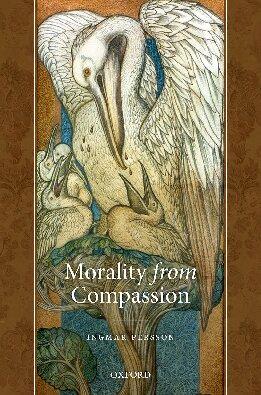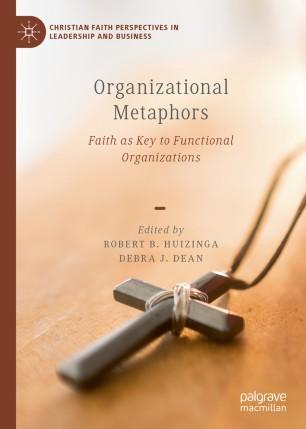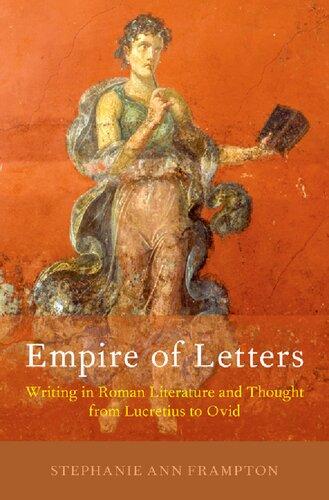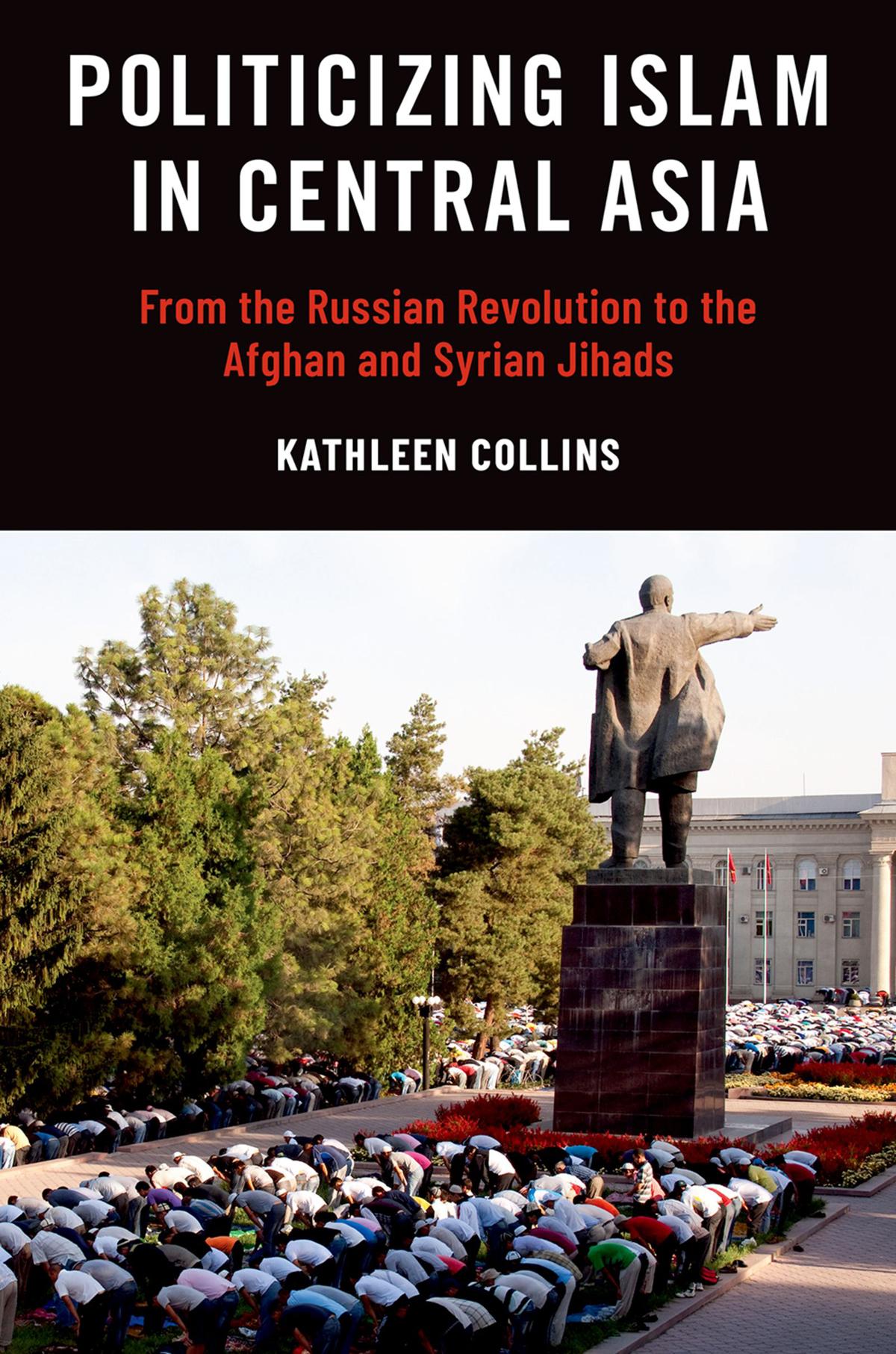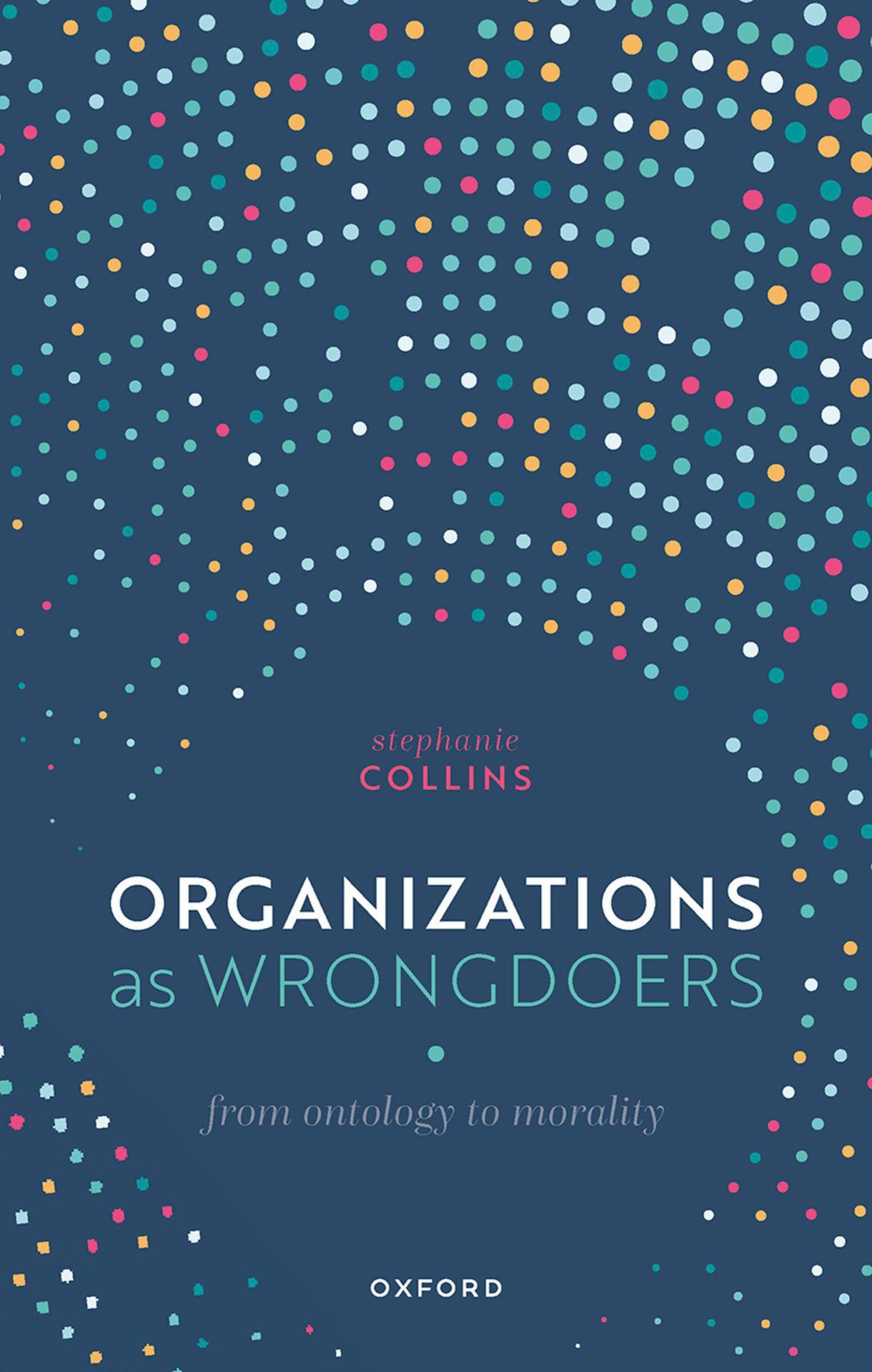Organizationsas Wrongdoers
FromOntologytoMorality
STEPHANIECOLLINS
GreatClarendonStreet,Oxford,OX26DP, UnitedKingdom
OxfordUniversityPressisadepartmentoftheUniversityofOxford. ItfurtherstheUniversity’sobjectiveofexcellenceinresearch,scholarship, andeducationbypublishingworldwide.Oxfordisaregisteredtrademarkof OxfordUniversityPressintheUKandincertainothercountries
©StephanieCollins2023
Themoralrightsoftheauthorhavebeenasserted FirstEditionpublishedin2023
Impression:1
Allrightsreserved.Nopartofthispublicationmaybereproduced,storedin aretrievalsystem,ortransmitted,inanyformorbyanymeans,withoutthe priorpermissioninwritingofOxfordUniversityPress,orasexpresslypermitted bylaw,bylicenceorundertermsagreedwiththeappropriatereprographics rightsorganization.Enquiriesconcerningreproductionoutsidethescopeofthe aboveshouldbesenttotheRightsDepartment,OxfordUniversityPress,atthe addressabove
Youmustnotcirculatethisworkinanyotherform andyoumustimposethissameconditiononanyacquirer
PublishedintheUnitedStatesofAmericabyOxfordUniversityPress 198MadisonAvenue,NewYork,NY10016,UnitedStatesofAmerica
BritishLibraryCataloguinginPublicationData Dataavailable
LibraryofCongressControlNumber:2022945694
ISBN978–0–19–287043–8
DOI:10.1093/oso/9780192870438.001.0001
Printedandboundby CPIGroup(UK)Ltd,Croydon,CR04YY
LinkstothirdpartywebsitesareprovidedbyOxfordingoodfaithand forinformationonly.Oxforddisclaimsanyresponsibilityforthematerials containedinanythirdpartywebsitereferencedinthiswork.
Acknowledgements vii
PARTI.METAPHYSICS
1.TheRealityofOrganizations3 1.1Overview3
1.2Organizations’ Attributes8 1.3RealismaboutOrganizations14 1.4TheQuestions24
2.TowardsaMetaphysicsofMembership27 2.1Introduction27
2.2Causation,Supervenience,Anchoring30
2.3GroundingandParthood36
2.4MembersasParts-Plus:ExistingAccounts42 2.5Conclusion48
3.AMetaphysicsofMembership50 3.1Introduction50
3.2Members:PartswithCommitments,Inputs,andEnactment51
3.3ObjectionsandReplies59
3.4MembersofCorporations65
3.5MembersofLiberal-DemocraticStates75
3.6Conclusion79
PARTII.BLAMEWORTHINESS
4.VarietiesofOrganizationalBlameworthiness83
4.1Introduction83
4.2VolitionismforOrganizations86
4.3AttributivismforOrganizations92
4.4AretaicismforOrganizations97
4.5Conclusion105
5.Organizations’ MoralSelf-Awareness107
5.1Introduction107
5.2RoboticBlameworthiness108
5.3WhyMoralSelf-AwarenessMatters113
5.4PluralandWe-modeSelf-Awareness120
5.5Organization-levelMoralSelf-Awareness122
5.6Conclusion130
PARTIII.MEMBERS
6.HowMembersAreImplicated133
6.1Introduction133
6.2Enactors136
6.3Endorsers142
6.4Omitters149
6.5Conclusion155
7.ApportioningMembers’ Burdens158
7.1Introduction158
7.2SourcesofCost161
7.3TheSource-TrackingModel163
7.4RespondingtoShortfalls171
7.5Conclusion183 Conclusions185 References 189 Index 199
Acknowledgements
Theideasinthisbookhavebeengestatingformorethanadecadeandhave followedmeto fiveuniversitiesinthreecountries.I firststartedthinking aboutgroupagentsin2010asaPhDstudentattheAustralianNational University,undertheprimarysupervisionofBobGoodinandNic Southwood.Itookthesethoughtstomy firstacademicjobatthe UniversityofManchester,wherein2016Iwrotethearticleonwhich Chapter7isbasedandin2017wrotethearticleonwhichSection6.3is based.In2019,IwrotethearticleonwhichChapter5isbasedwhileIwasa visitingresearchprofessorattheUniversityofVienna.The firstfulltypescriptwaswrittenin2020–2021,whileIwasattheAustralianCatholic University.FinalrevisionsweredonefromMonashUniversityin2022. Ithankeachoftheseorganizations and,moreimportantlytome,their members fortheirsupportandencouragement.
Financialsupportwasprovidedbytheaboveuniversities,butalsoby externalfundingbodies.ThisresearchwasfundedbytheEuropeanUnion’ s Horizon2020ResearchandInnovationprogrammeundergrantagreement No.740922,ERCAdvancedGrant ‘TheNormativeandMoralFoundations ofGroupAgency’.Isubsequentlyworkedonthebookwhileholdingan AustralianResearchCouncilDiscoveryEarlyCareerResearcherAwardfor theproject ‘Organisations’ Wrongdoing:FromMetaphysicstoPractice’ (projectnumberDE200101413).
Forhelpfulcommentsonpresentationsoftheideas,Ithankaudiencesat thefollowingevents:theUniversityofAucklandPhilosophySeminar, aworkshoponActsandOmissionsattheAustralianCatholicUniversity, theAustralianCatholicUniversity’sDianoiaInstituteofPhilosophy Workshop,aconferenceonCollectivityattheUniversityofBristol,the SocialOntology2021ConferenceattheUniversityofCaliforniaatSan Diego,theDeakinUniversityPhilosophySeminar,theCollective IntentionalityXConferenceatDelftUniversityofTechnology,theTU EindhovenPhilosophyandEthicsSeminar,aworkshoponCollective ResponsibilityatUniversityofJyväskylä,theUniversityofLeedsEthics andMetaethicsSeminar,theLondonSchoolofEconomicsPolitical PhilosophySeminar,theMacquarieUniversityPhilosophySeminar,a
workshoponCollectiveandSharedResponsibilityatthe2019Mancept WorkshopsinPoliticalTheoryattheUniversityofManchester,the MonashUniversityPhilosophySeminar,aworkshoponRoleEthicsatthe OpenUniversity,theUniversityofNewSouthWalesPhilosophySeminar, theOtagoUniversityPhilosophySeminar,aworkshoponStatesas CollectiveAgentsatPrincetonUniversity,aworkshoponGroupAgency andBeliefatStAndrewsUniversity,thePracticalPhilosophyWorkshopat SaarlandUniversity,theUniversityofSydneyPhilosophySeminar(twice), theUndergraduatePhilosophyJournalofAustralasia ’s2020Online Conference,theAustralasianAssociationofPhilosophy’s2021Conference attheUniversityofWaikato,theUniversityofWollongongPhilosophy Seminar,andthe2020SocialOntologyZoomFamilyReunion.
Forcommentsonwrittendraftsofindividualchaptersorthearticleson whichthey’rebased,IthankNevinClimenhaga,JonathanFarrell,Luara Ferracioli,SimonGoldstein,JohnHawthorne,FrankHindriks,Violetta Igneski,OleKoksvik,HollyLawford-Smith,AviaPasternak,James Pattison,RichardRowland,LiamShields,AnnaStilz,DavidStrohmaier, andHannahTierney.IthankHerlindePauer-Studerforseveraldeeply enrichingconversationsaboutChapter5.Forcommentsonfulldraftsof thebook,IthanktwoanonymousreviewersatOxfordUniversityPressand areadinggroupatMonashUniversityconstitutedbyWillCailes,Andy McKilliam,JamesMolesworth,AndrisRaivars,andSimonvanBaal.
Chapter5,Section6.3,andChapter7eachcloselyfollowtheargumentsof mypreviouslypublishedwork.Ithankthepublishersforpermissionto reprintsubstantialtractsofthebelowarticles:
Collins,Stephanie.2016. ‘DistributingStates’ Duties’ . JournalofPolitical Philosophy,24/3:344–66. Collins,Stephanie.2017. ‘FillingCollectiveDutyGaps’ Journalof Philosophy,114/11:573–91. Collins,Stephanie.2022. ‘I,Volkswagen’ . PhilosophicalQuarterly,72/2: 283–304.
TheRealityofOrganizations
1.1Overview
Organizationsdomoralwrong.Statespursueunjustwars,businessesavoid tax,andcharitiesmisdirectfunds.Oursocial,political,andlegalresponses requireguidance.Weneedtoknow what thethingiswe’rerespondingto and how weshouldrespondtoit.Weneedametaphysicalandmoraltheory ofwrongfulorganizations.
Thisbookprovidesanewsuchtheory,payingparticularattentionto questionsthathavebeenunderexploredinexistingdebates.Theunderexploredquestionsinclude:what’sthemetaphysicalrelationbetweenorganizationsandtheirmembers,andhowcanthishelpustomakesense oforganizations’ blameworthiness?Canorganizationsbeblameworthyin allthemyriadways ‘blameworthy’ isunderstoodincontemporarymoral theory?Andwhataboutfeelingsofguilt,remorse,andshame canorganizationsexperiencethesefeelingsinaphenomenologicalsense(notjusttheir ‘functionalequivalents’) andwhydoesthismatterfororganizations’ blameworthiness?Andiforganizationsarewrongdoers ‘intheirown right,’ thenwhatdoesthisimplyformembers?Howandwhyaremembers implicatedinorganizations’ wrongs,andhowshouldreparativecostsbe apportionedamongmembers?
Thisbookwillanswertheseandotherquestions.Indoingso,Iaimto bridgeadivide.Ononesideofthechasm,recentworkinsocialontologyhas aimedtoaccountforthemetaphysicsoforganizations.Butthisworkhasnot consideredhowthemetaphysicscanaddressthedistinctivemoralissues raisedbyorganizations’ wrongdoing.Ontheothersideofthechasm,recent workhastakengroups’ moralblameworthinessseriously,butwithout fullyestablishingtheunderlyingmetaphysicsandexploringhowthatmetaphysicscaninformourmoralconclusions.¹Inshort:themetaphysicaland
¹Forexample,ListandPettit2011andTollefsen2015addressgroupresponsibilitywitha focusontheunderlyingphilosophyofmind;Isaacs2011withanemphasisonphilosophyof action.
OrganizationsasWrongdoers:FromOntologytoMorality.StephanieCollins,OxfordUniversityPress. ©StephanieCollins2023.DOI:10.1093/oso/9780192870438.003.0001
moraltreatmentoforganizationshavebecomedetachedintheliterature. Thisbookaimstoattachthemandtodemonstratewhythatattachment matters.
Thebook’sprimarymetaphysicalthesisisthatmembersare material parts oforganizations muchastheengine,wheels,andsoonarethe materialpartsofamotorcycle.IargueforthisthesisinPartI(Chapters1, 2,and3).InPartII(Chapters4and5),Idemonstratethatthismetaphysical thesisyieldsimportantmoralconclusions:organizationscanbeblameworthyforawiderangeofactions,attitudes,andcharactertraits(including thoseofmembersquamembers)andorganizationscanliterallyfeelguilt (whenmembersfeelguiltquamembers).InPartIII(Chapters6and7), Iexploretheimplicationsoforganizations’ wrongdoingformembers. Icataloguethewaysinwhichmembers-as-material-partscanbeimplicated inorganizations’ wrongdoing.Aswewillsee,notallmembersareequally implicatedineachwrongdoingofeachorganization.Therearesomeorganizationalwrongdoingsinwhichonlyafewmembersareimplicated,despite thefactthatallmembersarematerialpartsoftheorganizationthathasdone wrong.Iarguethatthecostsoforganizations’ wrongdoingshouldbe distributedtomembersinproportiontomembers’ levelofimplicationin thewrongdoing,ratherthanbeingdistributedequallyonthebasisof membership-as-parthoodalone.
Intheseways,Iaimtoconnectthemetaphysicsandmoralityofwrongdoingorganizations.Ofcourse,notallreaderswillbeinterestedinthis connection.Thosewhoareinterestedonlyinthemetaphysicsmightstop readingafterChapter3.IhopethatChapters2and3willappealtoanyone interestedinthemetaphysicsofordinaryobjects notonlythoseinterested inthemetaphysicsof social objects.Meanwhile,thosewhoareinterested onlyinthemoralandpoliticalimplicationscanskipChapters2and3, withoutmuchlossofunderstanding(thoughsuchreaderswill,Ithink, beinterestedinSections3.4and3.5).Suchreadersareaskedsimplyto grantmetheassumptionthatmembersarematerialpartsoforganizations. IhopethatPartIII(Chapters6and7)willengageanyonewithaninterestin historicalinjusticeandreparations,regardlessoftheirinterestinmetaphysics. Still,thebook’sargumentsarebestunderstoodasformingacoherentwhole: themetaphysicalpictureisanimportantpremiseinthemoralarguments, whilethemoralargumentsexplainwhythemetaphysicalpicturematters.
Tosettleideasandbegintodemonstratethepracticalimportanceofthis inquiry,letmelayouttwoexamples.
In2019,Australiareceivedthe finalreportofitsRoyalCommissioninto MisconductintheBanking,SuperannuationandFinancialServices Industry.InAustralia,RoyalCommissionsengageininquiryandfactfinding.They’relessformalthanacourt,buttheyhavethepowertorefer entitiestocourtsforprosecution.Perhapsmostimportantly,theirpolicy recommendationsaretakenseriouslybygovernmentandthemedia.
TheBankingRoyalCommission(asI’llcallit)wassetuptoinquire whethertherewas ‘misconduct,orconductfallingshortofcommunity standardsandexpectations,inAustralian financialservicesentities’.Ifso, theCommissionwasaskedtoreportonwhetherthatconductwas ‘attributabletotheparticularcultureandgovernancepracticesofa financial servicesentityorbroaderculturalorgovernancepracticesintherelevant industryorrelevantsubsector’ andwhethertheconduct ‘result[ed]from otherpractices,includingriskmanagement,recruitmentandremuneration practicesofa financialservicesentity,orintherelevantindustryorrelevant subsector’ (2018,2).
TheCommissionrevealedthatAustralia’sbiggestbankshadengagedin widespreadandpervasivedishonestpractices.Theseincludedchargingfees whennoservicehadbeenprovided(includingtodeceasedcustomers),lying tocustomers,forgingcustomers’ signatures,impersonatingcustomers, falselywitnessingdocuments,transferringcustomers’ fundstoadvisors’ personalbankaccounts,underpayinginterestontermdeposits,andon andon.TheCommission’sreportattackedthe ‘culture ’ of ‘dishonestyand greed’ inAustralia’slargestbankingand financecorporations(Royal Commission2018,73;2019,138).TheCommission ’ s finalreportasserted thatthecorporationsthemselveswereculpableforthemisconductthe Commissionuncovered(2019,4).
YettheCommissiondidn’texplicitlyendorsetheideathatthebankswere blameworthyinamanner ‘irreducible’ totheblameworthinessoftheindividualsinvolved.Instead,theCommissionsimplyraisedthequestion: ‘[s]houldtherebemorefocusoncriminalproceedingsagainst[banksand financialinstitutions]ratherthanindividualadvisors?’ (RoyalCommission 2018,158).Itleftansweringthisquestiontothepoliticiansandbureaucrats whoweretheprimaryaudienceofitsreport.Inthis,theCommission arguablysubmittedtoalongtraditioninAustraliaofviewingcorporations as ‘legal fictions’,withindividuals(suchas financialadvisors)beingtheones
whoarechasedbythelegalsystem.TheCommissionleftituptoregulators whetherthistraditionshouldbeoverthrown.
YoumightthinktheCommission ’squestionisalegalone,notaphilosophicalone.ButAustralianlawgivesaphilosophicallycontentiousanswer. Australia’sCriminalCode ‘appliestobodiescorporateinthesamewayasit appliestoindividuals ’—yetitallowsforprosecutionofacorporationonly when ‘anoffenceiscommitted byanemployee,agentorofficer ...withinthe actualorapparentscopeofhisorheremployment,or ...authority’ (CriminalCodeAct1995 (Cth),Part2.5,Sec.12.1,emphasisadded). Crimescanalsobeattributedtoa ‘corporateculture’,understoodas ‘ an attitude,policy,rule,courseofconductorpracticeexistingwithinthebody corporategenerallyorinthepartofthebodycorporateinwhichtherelevant activities[ofemployees,agents,orofficers]takeplace’ (CriminalCodeAct 1995 (Cth),Part2.5,Sec.12.4).Butevenwithinthis ‘corporateculture’ provision,identifiablewrongfulactivities ofindividuals arewhat’sattributed tothecorporateculture.Andthecorporatecultureprovisionhasrarelybeen used,sothereislittleclarityoverhowtointerpretandapplyit(Hill2003; Adamsetal.2017).Theupshot:legally,inAustraliaatleast,corporate criminalwrongdoingsgenerallyexistonlywhenindividualcriminalwrongdoingsexist.
Inrecentyears,severalphilosophershaveprovidedpicturesofcollective wrongdoingthatallowustoarguethatthislegalorthodoxyiswrong-headed (e.g.,French1984;Pettit2007;Isaacs2011;Tollefsen2015).However,as Iaimtoshow,ourcurrentphilosophicalpictureofcorporatewrongdoingis incomplete.Therefore,ourpotentialtoprovideafullanddefensibleanswer totheCommission ’squestionisalsoincomplete.Thisbookwill fillthegaps, providingthetheoreticaltoolsforustoanswertheCommission’squestion ofwhetheritisdesirable orevendefensible,orevenpossible tohold organizationsthemselvesculpable.
What’strueoflegalwrongdoingisalsotrueoflegalmetaphysics:the picturethatprevailsisanindividualistpicture.Theabovelegalapproachto corporatecriminalwrongdoingreflectsthefactthatmuchofAustralia’ s corporatelawseemstoemployashareholder-basedmetaphysicsofcorporations,inwhichthecorporationisidentifiedwithitsshareholders(Hill2003; thisviewhasrecentlyreceivedphilosophicaldefenceinLudwig2017a) or, onlyslightlylessreductively,witha ‘nexusofcontracts’ thatincludesemployees,suppliers,customers,andsoon(JensenandMeckling1976).
Thenexus-of-contractsmodelarguablyencouragesthereductionofthe corporationanditswrongdoingtoindividualsandtheirwrongdoing:onthis
model,ifwecan findoutwhatthoseinthenexushavedone,thenwewill havefoundoutwhattheorganizationhasdone.Butorganizationalwrongdoingisbothnarrowerandbroaderthanthis.It’snarrowerinsofarasmany inthecontractualnexus suchassuppliersandcustomers shouldnot havetheiractionsattributabletothecorporation.Andit’sbroaderinsofar aswrongssometimesseemattributabletocorporations’ cultures (asthe BankingRoyalCommissionclaimed).It’sunclearwheretolocatea ‘culture’ withinanexus-of-contractsmetaphysics.Allofthissuggeststhatphilosophy canhelptoanswertheCommission’squestion inbothitsmoraland metaphysicaldimensions.
1.1.2ThePolluterPaysPrinciple
AsecondexampleistheroleofthePolluterPaysPrincipleindistributing thecostsofmitigatingthedevastatingeffectsofclimatechange and,in particular,inimplementingthe2015ParisAgreementundertheUnited NationsFrameworkConventiononClimateChange.ThePolluterPays PrincipleassertsthatindustrializedstatesshouldsethighemissionsreductiontargetsundertheParisAgreement,becausethesestatesareculpablefor wrongfullyhighhistoricalemissions.Disagreementoverthetruthofthe PolluterPaysPrinciple(amongmanyotherthings)haspreventedstates fromsettingsufficientlyambitiousemissionsreductiontargetsunderthe ParisAgreement.Predictably,developingstatesargueinfavourofthe principlewhiledevelopedstateresistit(Stavins2018).
IfwearetovindicatethePolluterPaysPrinciple,weneedaconceptionof statesasunitaryactors,whononethelessrelatetotheircitizensinsuchaway that(i)citizens’ pollutingactionsareattributabletostatesand(ii)costs attributedtopollutingstatescanjustlybepassedontoawidediversity citizens includingpassedontocitizenswhoarenotthemselveswrongful polluters.PartsIandIIofthisbookvindicatepoint(i),whilePartIII vindicatespoint(ii).
AswithAustralia’sBankingRoyalCommission,thelawgetsusonlysofar insortingouttheseissues. Brownlie’sPrinciplesofPublicInternationalLaw (Crawford2012)isthecanononstates ’ legaltreatment.Here,statesare metaphysicallyconceptualizedasunitaryactorsratherthana ‘nexusof contracts’ oracollectionofindividuals.Butintheplaceofthenexusof contracts,there’sanemptyhole:states’ relationtoindividualsisleftentirely untheorized.It’sasifstatesarecompletelyseparatefromtheirindividual
constituents whethertheseconstituentsareconceptualizedsoastoinclude ordinarycitizens,ornot.PartIofthisbookaimsto fillthehole.
Andneedlesstosay,theforceofinternationallawhasnotbeenused againststateswhoarehighemitters.Noneofthemhavebeencondemnedby theUnitedNationsSecurityCouncilorreferredtotheInternationalCourt ofJustice,forexample.Philosophycanhelpustoworkoutwhetherthat wouldbemorallyappropriate.AlthoughChapters2and3willarguethat citizensarethe materialparts oftheirstates,Chapter4willdemonstrate thatmanyofthemoralfailingsoforganizations includingstates cannot belocatedinthewrongfulactionsofindividuals.Organizations’ moralfailings oftenlieinorganizations’ evaluativeattitudes or charactertraits,wherethese organizationalattitudesandtraitsarenotstraightforwardlyunderstandablein termsofthewrongfulevaluativeattitudesorwrongfulcharactertraitsof members.Thisanalysisrevealstheshortcomingsofexistingtreatmentsof organizations’ wrongdoing,whichhavetendedtofocusonorganizations’ blameworthinessfortheirirreduciblygroup-level choices or decisions.Ifwe canholdorganizationsblameworthyfortheirevaluativeattitudesandtheir charactertraits(notjusttheirchoicesordecisions),wepotentiallygetmany moreenvironmentallynegligentorganizationsonthehook.
Thesetwoexampleswillrecurthroughoutthebook’sdiscussion,helping toillustrateandproblematizevariousclaimsthatI’llconsideranddefend. Butthisisabookofphilosophy.Myargumentswillremaintheoreticaland general,withthedetailssketchedprimarilyviathesetwoexamples.To introducethebook’sphilosophicalapproach,therestofthisintroductory chapterturnstotheoreticalissues.Iwill firstoutlinehowIconceptualize organizations.I’llthenbrieflyexplainwhyweshouldberealistsaboutthem. Finally,Iwillgiveanoverviewoftheargumentstocomeintherestof thebook.
1.2Organizations’ Attributes
InoutliningtheBankingRoyalCommissionandthePolluterPaysPrinciple, I’vemadeanassumptionthatmaysurprisesomereaders.I’veassumed statesareorganizations.Often,whenwehear ‘organization ’,wethinkof largecorporationsandcharities,butnotstates.²Myusageisbroader.AsI’ll
²ThoughI’mcertainlynotthe firsttoarguethatstatesarecollectivemoralagents(seee.g., Erskine2001;Erskine2003;Wendt2004).
usetheterm,an ‘organization’ is acollectiveagentthatinvolvesalarge numberofpeoplewhorealizeastructurethatcoordinatesdividedlabourvia rulesandhierarchicalcommandrelations,guidedbyacollectivedecisionmakingprocedure.
Thisdefinitionisintendedtobeecumenicalbetweenmanydifferent characterizationsfoundacrosstheacademicliterature.Itfollowsalong traditioninsociology,startingwithMaxWeber ’scharacterizationofbureaucraciesasinvolvingrulesandregulations,adivisionoflabourand responsibility,andhierarchicalauthoritystructures(1968,vol.I,223ff.; 1968,vol.III,956ff.).Morerecently,sociologistshavegivensimilaranalyses ofinstitutions,suchasRomHarre’sviewofaninstitutionas ‘aninterlocking double-structureofpersons-as-role-holdersoroffice-bearersandthelike, andofsocialpracticesinvolvingbothexpressiveandpracticalaimsand outcomes’ (1979,98)orJonathanTurner’sde finitionofaninstitutionas ‘ a complexofpositions,roles,normsandvalueslodgedinparticulartypesof socialstructuresandorganizingrelativelystablepatternsofhumanactivity’ (1997,6).Myuseof ‘organization’ ratherthan ‘bureaucracy ’ or ‘institution ’ reflectsrecentphilosophicalusage,inwhich ‘bureaucracy’ hasfallenoutof thelexicon,while ‘institution’ isoftenusedtocaptureawiderrangeof phenomena includinginstitutionssuchasmarriageorpromise-keeping, whicharenot ‘organizations’ inanysense.
Mycharacterizationoforganizationsalsoroughlymatchesrecentmanagementtheory,particularlyGeoffreyM.Hodgson ’sdistinctionbetween socialstructures,institutions,andorganizations.AccordingtoHodgson, ‘[s]ocialstructures includeallsetsofsocialrelations,includingtheepisodic andthosewithoutrules,aswellassocialinstitutions. Institutions are systemsofestablishedandembeddedsocialrulesthatstructuresocial interactions. Organizations arespecialinstitutionsthatinvolve(a)criteria toestablishtheirboundariesandtodistinguishtheirmembersfromnonmembers,(b)principlesofsovereigntyconcerningwhoisinchargeand (c)chainsofcommanddelineatingresponsibilitieswithintheorganization’ (Hodgson2007).
Inadditiontosociologyandmanagementtheory,mycharacterization resonateswithrelatedworkinphilosophy.Thusmy ‘organizations’ include PeterFrench’ s ‘conglomerates’,whichhave(i)internalorganizationor decisionproceduresforchoosingcoursesofaction,(ii)enforceablecodes ofconductformembers,and(iii)memberswhoreplaceablyoccupyroles thatprovidethemwithpoweroverothermembers(French1984,13ff.).My viewlikewisedovetailswithRaimoTuomela’sviewofagroupagentas ‘ an
interactivesocialsystem ...thatconsistsofinterrelatedindividualssuchthat thissystemis,throughthem,capableofproducinguniformactionsand outcomes’ (2013,21).
Becausemydefinitionencompassestheabovedefinitions,Ihopethatmy metaphysicalandmoralclaimswillappealtoarangeofdifferenttheorists, whomightsubscribetodifferentoftheabove-citeddefinitionsandcharacterizationsoforganizations.Thatistosay,myaimhereisnotto improve on anyofthedefinitionsquotedabovefromothertheorists.Rather,Iaimfor mydefinitiontobeconsistentwith andneutralbetween alltheabove definitions.Thatsaid,mydefinitionraisesaquestion:whatmakesorganizations(asI’vecharacterizedthem)worthyofaunitaryanalysisaswrongdoers, despitethevastdifferencesbetweenvarioustypesoforganization states,forprofits,andnon-profits,forexample?Afterall,manyphilosophersdifferentiateorganizationsaccordingtothoseorganizations’ ends(e.g.,French1984; Rovane1998;Miller2010).Onemightthinkthatorganizationswithdifferent endsshouldbeconceptualizeddifferentlyaswrongdoers.
Onthecontrary,thevariouscomponentsofmydefinitiondemonstrate thatorganizationswarranttreatmentasaclass.First,considerorganizations ’ largesize.By ‘large’,Imean ‘largeenoughthatnotallmembersareknownto oneanotherpersonally’.Thenumericalcut-offherewilldifferfordifferent organizations,dependingonhowchannelsofcommunicationaresetup. Definitionally,allorganizationsarelargeenoughthatmemberscannothave pairwisein-depthconversationsabouttheorganization ’splansandpolicies (atleast,notconsistentlywithhavingthetimetoensurethoseplansand policiesareenacted).Thisissignificant,becauseitmeansthatitisextremely unlikelyfortheretobeperfectuniformityamongstmembers’ reasonsfor supportingoropposingparticularplansorpolicies,oreventheirinterpretationsofthecontentofplansandpolicies.Thememberscannotgather aroundatabletoreachaconsensusviewonthewhysandhowsoforganizationalpracticesandpolicies.Thismandatesheterogeneityinhowwetreat membersofwrongdoingorganizations,asPartIIIofthisbookwillexplain. Suchheterogeneityiscommontoorganizations,whilenotalwaysbeingtrue ofsmaller,morecollaborative,collectiveagents.Thelackofcohesion entailedbyorganizations’ largesizealsomeansthatorganizations’ members cannotsimplybepickedoutbythefactthattheyallshareidenticalgoals, visions,orvalues.Amorecomplicatedaccountofmembershipisrequired, asChapters2and3willexplain.
Second,themembersoccupyplacesinastructure.Astructureisa collectionofrolesthatstandinrelations.Inanorganization,therolesare
jobsortasksandtherelationsareusuallyreportinganddelegationlines.The rolesandtheirrelationscanbehighlydiverse.Boththerolesandthe relationsarerepresentableinanorganizationchart(thatdepictstheroles as ‘nodes’ andtherelationsas ‘edges ’).
Organizationsarecomposedofpeoplewho ‘realizeastructure’—thatis, occupytherolesinthestructure.Astructureisanabstractrepresentationof variousrolesandoftherelationsbetweenthoseroles.Asananalogy,wecan thinkofarecipe.Arecipeisanabstractrepresentationofvariousroles(the onionrole,thegarlicrole,andsoon)andofhowtheoccupantsofthoseroles mustberelatedtooneanotherinordertorealizeacertaindish.Forthedish toberealized,wemust findparticularrole-occupants(particularonions, particularbulbsofgarlic,andsoon)andwemustmakeitthecasethatthose role-occupantsarerelatedinsuchawayastofollowtherecipe.³
FollowingKatherineRitchie,sayingthatanorganizationiscomposedof peoplewhorealizeastructureallowsustosaythatanorganization is a realizedstructure,whereastructureis ‘realized’ whenenoughpeople occupythestructure ’sroles.(Howmanyis ‘enough’?Thatwillbedictated bytheorganization’sdecision-makingprocedure somethingIwillcharacterizeshortly.)Thisideaofstructuregivesusanexplanationofhowan organizationisboth ‘ one ’ and ‘ many ’.Itis ‘ one ’ becauseitisarealized structure asinglething.Itis ‘ many ’ becauseitisthemanyindividualswho occupyitsroles.⁴
Chapters2and3willsaymuchmoreaboutthemetaphysicshere. Speci fically,Iwillarguethatmembersare physicalparts ofanorganization, andthatanorganizationis located whereveritsmembersare.Thiswill incorporateorganizationsintoanaturalist,materialistviewoftheworld. Fornow,theimportantpointisthis:sinceallorganizationsarerealized structures,thejust-mentionedmetaphysicalviewscanapplyinthesame waytodifferenttypesoforganizations(states,for-profits,non-pro fits,and soon).Thisvindicatestheprojectofdevelopingaunifiedtheoryoforganizationsaswrongdoers.
³TherecipeanalogycomesfromKathrinKoslicki’s(2008)discussionofordinaryobjects. ⁴ SeeRitchie(2013).Harris(2020,360–1)objectstoRitchie’sparticularversionofthe organizations-as-structureview:structuresdonotallowforchangesinmembers,roles,or relations;clearly,organizationscanchangemembers,roles,andrelationswhileremainingthe sameorganization.Wecanrespondtothisbysayingthattworealizedstructures,whichexistat differenttimes,arethesameorganizationjustincasethelaterstructureisdescendedintheright wayfromtheearlierstructure.
Third,anorganizationhasadivisionoflabour.Membersdon ’tknow allthedetailsofwhatalltheothersaredoingvis-à-vistheorganization’ s plansandpolicies.Thiscomplicatestheextenttowhicheachcanbeheld blameworthyforwhattheothers(failto)do.Diminishedindividualblameworthinesshastwoimplications.First,itgeneratesanimperativethat wehaveasoundtheoryofdistinctivelyorganization-levelwrong,since oftenwewon’t findindividual-levelwrongsthatareproportionatetoan organization-levelwrong.PartIIofthisbook(Chapters4and5)theorizes distinctivelyorganization-levelwrongs,includingdistinctivelyorganizationlevelguilt.Second,diminishedindividualblameworthinessimpliesthatwe needtotakecarewhenspellingouttheimplicationsoforganizations’ wrongdoingsformembers,sincethoseimplicationswillnotbeasuniform astheywouldbeinagroupwithlessinformationalasymmetrybetween members.ThoseimplicationsformembersarespelledoutinPartIII (Chapters6and7).
Fourth,anorganizationhasrulesandhierarchicalcommandrelationsvia whichitpursuesitsplansandpolicies.Thesematterbecause similartothe informationalasymmetriesthatresultfromthedivisionoflabour they sometimesattenuateindividuals’ blameworthiness.Ifanindividualhas perfectlygoodreasontotrustthesystem,thenshemaybeperfectlywithin reasontoobeytherulesand/orhersuperiors.Yetiftherulesthemselves,or thecommandrelations,aremorallywrong,thenthiscanleadtothe organizationdoingwrong.Thisphenomenoniscommonacrossawide rangeoforganizations,eveniftheprecisedetailsvary.
Worse,becausetherulesandcommandrelationsarethemselvesdesigned throughaprocesswithadivisionoflabour(includingthroughlegislation andregulationthatisimposeduponorganizationsfromtheoutside),there maybenoindividualwhoisblameworthyforthefactthattherulesand commandrelationsareastheyare.ThisrelatestoAnthonyDowns’‘Lawof ImperfectControl’,accordingtowhichnooneindividualcanfullycontrola largeorganization aswellashis ‘LawofDiminishingControl’,according towhichthemoreeffortatcontrolismadeatthetop,themoresubordinates willtrytoevadeorcounteractsuchcontrol(Downs1967,143–50).Thus, rulesandhierarchicalcommandrelationshipscanrelieve both superiors and subordinatesfromblame.Ofcourse,thisisnottosayindividualswithin organizationsareneverblameworthy:Chapter6willspelloutmanywaysin whichindividualscanbeimplicatedinorganizations’ wrongdoing,and Chapter7willjustifyindividualsbearingcoststorepairtheirorganizations’ wrong.Again,though,thesephenomenaarecommonacrossawiderangeof
organizations,vindicatingtheprojectofdevelopingaunifiedtheoryof organizationalwrongdoing.
Thus,organizationsaredistinctivebyvirtueofbeingcomposedofalarge numberofpeoplewhoareoccupyplacesinastructurethatcoordinates dividedlabourviarulesandhierarchicalcommandrelations.Thismakes themworthyofaunifiedanalysis.Andtherearegoodreasonstowanta unifiedanalysis.Byaimingatunity,ourtheoryisforcedto fitwithawider rangeofcasestudiesandexamples.Allelsebeingequal,thismakesour theorybetter.Thatis:ifwedevelopedatheoryofwrongdoingfor(say) corporationsbutnotstates,thenwe’dneedtodevelopaseparateaccountof statesaswrongdoers.Ourover-archingtheorywouldthereforebeless unifiedandlesssimple.Ifwecandevelopatheorythatappliestoall organizationsinaunifiedway(asIsuggestwecan),thenthisispreferable togoingbacktothedrawingboardforeachandeverydifferenttypeof organization.
Atthesametime,though,it’sworththeorizingaboutorganizations specifically,ratherthanaboutcollectiveagentsmoregenerally.Thisis becauseorganizationsraisetheirownproblems,asjustsummarized. Whilethetheorydevelopedinthisbookmightapplytocollectiveagents moregenerally,Iwanttomakesurewegetorganizationsright.
Whatare ‘collectiveagentsmoregenerally’?Isaidearlierthatorganizationsare collectiveagents thatare guidedbyacollectivedecision-making procedure.Inmyview,allcollectiveagentsareguidedbyacollective decision-makingprocedure(Collins2019a,ch.6).Specifically,acollective agentiscomposedofagentsunitedunderarationallyoperatedgroup-level decision-makingprocedurethatcanattendtomoralconsiderations.Thus, eachcollectiveagenthasitsowndecision-makingprocedure.Importantly fororganizationsspecifically,acollective’sdecision-makingprocedure includestheinformal,tacit,andvagueproceduresthatwemightsubsume underthenotionofanorganization’ s ‘culture’ (WeickandSutcliffe2001, ch.3;Herzog2018).Whyinclude ‘culture’ withinacollectiveagent’ s ‘procedure’?Becausethenorms,practices,andtraditionsthatconstitutea cultureoftenhugelyconstrainthereal-worldinstantiationofanyabstractly defined ‘formalprocedure’.Think,forinstance,ofacommitteewhose formalprocedureis ‘egalitariandiscussionamongstcommitteemembers’ Whenthisformalprocedureisactuallyinstantiated,culturewillinevitably haveastronginfluence.Forexample,traditionandnormsmightinformally decreethatoldermalemembersspeak first,orforlonger,orwithmore authority.Suchculturalaspectsofanactually-instantiatedprocedurewill
oftenbecrucialforunderstandingtheprocedure’soperationandoutputs. Chapter3willsaymoreaboutorganizationalmembershipandhowmembersrelatetoanorganization’sdecision-makingprocedure.
Myaccountofcollectiveagencyproducesabroadchurch.Twofriends decidingwheretogoforlunchareacollectiveagent,justasmuchasBP, France,orOxfam.Thus,manycollectiveagentsarefarmoreunstructured, undivided,discretionary,small,andegalitarianthanorganizations.Forthe purposesofanalysingcollectiveagents’ wrongdoing,itisusefultostudy organizationsspecifically,ratherthanthebroadchurchofcollectiveagents moregenerally(aswasdoneby,forexample,Isaacs2011;ListandPettit 2011;Tollefsen2015).Thisisbecauseofthefactorsmentionedearlier: organizationsare(i)composedofmanypeople,(ii)whorealizeastructure, (iii)withadivisionoflabour,(iv)governedbyrulesandhierarchical commandrelations.Thesefactorsproducethecomplicationssketched above,whichwillbediscussedasthebookproceeds.
1.3RealismaboutOrganizations
Sofar,wehavetwoexampleswhereorganizations’ wrongdoingisatstake butcontestable.Andwehaveaconceptionoforganizationsthatrenders themadistinctcategory.Thereisonemorepreliminarytoestablishinthis chapter:realismaboutorganizations.Thisistheviewthatorganizations ‘ are entitiesoverwhichwequantifyinthesetofourbestdescriptionsand explanationsofthesocialworld’ (Sheehy2006,132).
Aswithanyphilosophicalposition,realismaboutorganizationsis contested notjustinphilosophy,butalsoinorganizationtheory,business ethics,sociology,andeconomics.⁵ Itisnothardtoseewhyitiscontested.We don’tseemtobumpintoorganizationsinthestreet.Wemightbumpinto theirbuildingsorbillboards,butthesethingsarebuildingsorbillboards they arenot,themselves,organizations.Itisnotclearwhereorganizations are. (IwilldefendaviewofwheretheyareinChapters2and3.)Andifit’snot clearwheretheyare,thenit’snotclearhowtheycouldpossiblybepartofthe causalpathwaysofthenaturalworld.Thosecausalpathwaysrequireaspatiotemporallocation,orsoitseems.Furthermore,whenwelookoutintothe
⁵ RecentscepticsincludeHeugens,Kaptein,andvanOosterhout2008,Rönnegard2015, andLudwig2017a tracingbacktoPopper1945,Hayek1948,Weber1968,Weick1979,and Elster1989.
socialandpoliticalworld,whatwe do seeisindividualhumans.Oursociety andpoliticsseemstobemadeupofhumans.Whilewemightsometimesrefer togroupsofhumans,itistemptingtoviewthisas ‘mereshorthand’ for humansthemselves.
Despitethesecriticisms,realismiswidelyenoughaccepted andthe reasonsforithavebeenwidelyenoughcirculated thatmydefencehere willbebrief,schematic,andfamiliartomanyreaders.⁶ Thistruncated defencewillenabletheremainingchapterstoforgenewground.Thereare threebroadreasonsforrealismaboutorganizations:theirmultiplerealizability,theirinwardandoutwardcausal-explanatorypower,and(whatI’ll call)theirfunctionalist-interpretivistagency.
1.3.1MultipleRealizability
Therearemultiplewaysorganization-levelfacts,properties,events, andexplanations aswellasorganizationsthemselves,asobjects canbe realizedbyindividual-levelfacts,properties,events,explanations,and objects.(Thereadermightdoubtthatorganizationsareobjects;Iwillrender thisplausibleinChapters2and3.)Consideran event:theeventofAustralia permittingalargenewcoalminetobebuilt.Wecouldinsteadhaveconsidered thefact thatAustraliahaspermittedthemine,orAustralia’ s property ofhavingpermittedthemine,oran explanation oftheminethatincludes Australia’shavingpermittedit,orthe entity thatisAustralia allofthese are ‘multiplyrealizable’ inrelevantindividual-levelphenomena.By ‘multiplyrealizable’,Ijustmeanthatindividual-levelphenomenacouldhave beenavarietyofdifferentways,consistentwiththeorganization-level phenomenonremainingexactlythesame.Ifocusonphenomenathatare events,justtosettleideas.(Fordiscussionofthedifferencesbetweenthe
⁶ See,e.g.,GoodpasterandMathews1982,Ruben1985,Pettit1996,Hatch1997,Reed2001, Fairclough2005,Hess2013,andThomasson2019.Inherinfluentialoverviewoforganization theory,Hatch(1997)dividesorganizationtheoryinto ‘modern’ , ‘symbolic’,and ‘postmodern’ perspectives.InthesenseI’musinghere,allthreeperspectivesare ‘realist’.Themodern perspectiveanalysesorganizationsasagentsofrationalcontrol;thesymbolicperspective viewsorganizationsassitesofculturalmeaningandsymbolism;andthepostmodernperspectiveviewsorganizationsasideologicallydrivenforcesofhegemonicpower.Myargumentscan bewieldedfromanyoftheseperspectives.Moregenerally,themetaphysicalandmoralissues addressedinthisbookcross-cutdebatesinorganizationtheoryaboutorganizations’ interests, values,andmeanings.
multiplerealizabilityofsocial-levelproperties,facts,events,andsoon,see ListandSpiekermann2013.)
Theindividual-leveleventsthatconstitutetheAustralia-leveleventmost prominentlyincludeactionsonthepartofstatebureaucrats.Andeachof theseindividual-leveleventscouldhavegonevariousways:individuals couldworkmoreorlessreluctantly,callously,carefully,obediently,etc. Eachofthesepossiblerealizationsis ‘Australiapermittingthemine,’ just solongastwoconditionsaremet.
First,ineachrealization,theindividualactionsareperformedbymemberswithintheconstraintsof,andbecauseof,theirroleinAustralia;or,as Iwillequivalentlysay,theactionsareperformedbymembers whiletheyare performingtheirrole.Thisiswhatmakestheeventoneof Australia permittingthemine,ratherthanoneofsomeprivateindividualsabusing Australia’sprocedurestoproduceapermissionforthemine.Second,the permissionofthemineresultsfromeachrealization.Thisiswhatmakesthe eventoneofAustralia permittingthemine,ratherthanmerely trying to permitthemine.
Ifthesetwoconditionsaremet,theneachrealizationisarealizationof Australia’spermittingthemine.Therealizationsaredifferentfromeach other,sincetheyeachinvolveindividualsperformingdifferentactions. Thus,therealizationsarenotidenticaltoeachother.It’salsonottruethat alltherealizationsareidenticaltothepermittingofthemine iftheywere, andifweaccepttransitivityofidentity,thentherealizationswouldalsohave tobeidenticaltooneanother(whichwe’vealreadyruledout,becausethey arediscerniblefromoneanother).Wealsocannotarbitrarilychoosejust onerealization,andsaythatthepermittingofthemineisidenticalto that realizationbutnotanyoftheothers:ifwedidthat,thenthepermittingofthe minewouldnotoccurifoneoftheotherrealizationshappened.So,we shouldsaythatthepermittingofthemineissomethingdistinctfrom,but thatunites,thedistinctrealizations(JacksonandPettit1992;Listand Menzies2009).Thisisjusttosaythatweshouldberealistsaboutthe organization-levelevent.
Importantly,ifthemultiplerealizabilityofsomeorganization-levelphenomenonistorenderitdistinctfromitsindividual-levelrealizers,thenthe differentpotentialindividual-levelrealizersmustbeofdifferenttypes,not justdifferenttokensofthesametype(Shapiro2000;Couch2004).Tosee this,considertheanalogouscaseinphilosophyofmind.Supposemypain isalwaysrealizedbyC-fibres firinginmybrain,thoughdifferentC-fibres fireondifferentpain-occasions(becauseC-fibresdegenerateandare
replacedbynewones).Then,painisequivalenttoC-fibres firing.Forpainto benon-equivalentto(i.e.,distinctfrom)itsneuralrealizers,theremustbe different types ofpotentialneuralrealizers.Thisholdsinourexample: Australia’sactofpermittingtheminecouldhavebeensecuredbylegislation, orbyajudicialruling,orbytherun-of-the-millimplementationofsome existingpolicy,orinsomeotherway.Thesearealldifferent types ofrealizers oftheorganization-levelevent.
Otherphilosophershavesimilarlyusedmultiplerealizabilitytoarguefor organizations’ existence,butthoseargumentshavetendedtofocusonhow anorganizationmanifestsitselfacrosstime(e.g.,ListandPettit2011;List andSpiekermann2013).Suchcross-temporalargumentssaysthatanorganizationpersiststhroughtimeevenwhileitsmembersalter.Forexample,an organizationpersistseventhoughsomemembersleavewhileothermembersjoin.Suchpersistenceacrosschangesinmembershipprovidesreasonto viewtheorganizationasametaphysicallydistinctentity.Butsuchcrosstemporalchangeisnottheonlyrelevantkindofmultiplerealizability.
Insteadoftrackingtheorganizationacrosstime,wecantracktheorganizationacrossdifferentpossibleworlds:evenifmembersneverchangeinthe actualworld,weshouldberealistsabouttheorganizationifit’struethatthe organization would persist were memberstochange.Thecounterfactual (ratherthancross-temporal)versionofmultiplerealizabilityisworthwhile forafewreasons.First,itenablesrealismaboutabroaderpooloforganizationsthanthecross-temporalversionoftheargument.Second(andmore importantly),itenablesustoassessjusthow robust theorganizationalentity is.Wecanaskacrosshowmanychangesinmembership(oracrosswhat kindsofchangesinmembership)theorganizationwouldremain.Ofcourse, anysurvivalacrosschangesinmembershipgivesusreasontopositthe organization.Butamorerobustentity anentitythatwouldsurvivea higherormorediverserangeofchangestoitsmembership islikelyto havemoreexplanatorypower,andsomorereasontobeposited.Thisbrings ustothesecondreasonforrealismaboutorganizations.
1.3.2InwardandOutwardCausal-ExplanatoryPower
Above,Imentionedthatonemightquestionorganizations’ explanatory power,becauseonemightquestionwheretheyareplacedinthenatural world.IwilladdressthatissueatlengthinChapters2and3.Bracketingthat issuefornow,wecanseethatorganizationshavecausal-explanatorypower
intwodirections.Theyhave inward causal-explanatorypowerinsofaras organizationalfacts,properties,events,andentitiescancausallyexplain facts,properties,events,andentitiesinternaltotheorganization.And organizationshave outward causal-explanatorypowerinsofarasorganizationalfacts,properties,events,andentitiescancausallyexplainfacts, properties,events,andentitiesexternaltotheorganization.Inwardcausalexplanatorypowerimpliesthat(anevent,fact,property,etc.thatinvolves) theorganizationsometimescauses(anevent,fact,property,etc.that involves)its components beingcertainways.Outwardcausal-explanatory poweroccurswhen(anevent,fact,property,etc.thatinvolves)anorganizationcausallyexplains(anevent,fact,property,etc.thatinvolves)phenomena external totheorganizations.Outwardcausal-explanatorypower demonstratesthatorganization-levelexplanationsaredifferentfroman aggregationofexplanationsthatareabouttheorganization’scomponents.
Tointuitivelyseeinwardcausal-explanatorypower,consideragainthe caseofAustraliapermittinganewcoalmine.Toadequatelyexplainor describethemembers’ actionsthatconstitutetheorganization ’saction to capturemembers’ motivations,constraints,goals,etc. weneedtoreferto theorganization ’sdistinctfeatures(e.g.,judgements,goals,intentions,procedures).Wecanimagineabureaucratwhoisentirelyopposedtopermittingthemine whoevensecretlycampaignedagainstitonweekends yet whodoesherroleinimplementingAustralia ’sdecision.Tofullyexplainand motivatethisindividual’sactions,weneedtorefernotjusttofactsabouther, butalsotofactsaboutAustralia specifically,thatAustraliadecidedto permitthemine.Heractionis,inasense,notherown(atleast,it’snot just herown).Thelocusofagencybehindheractionis(also)Australia’ s. ThisisthesamesenseinwhichthewrongdoingsuncoveredbytheBanking RoyalCommissionswereproblems withthebanks,notjustwithindividuals withinthebanks,andprovidesarationaleforwhythePolluterPays Principletargetshistoricallyemitting states,notjustcollectivesorindividualsgovernedbythosestates.(Forsimilarpointsoninwardexplanatory power,seeElder-Vass2007,32–4.)
Tointuitivelysee outward causal-explanatorypower,considerthat organizationscancauseeffectstheirmemberscouldnotcause,werethose memberstolackthepropertiesinvirtueofwhichtheyrealizetheorganization’sstructure.Thecoalmine situatedonpubliclandinAustralia could notbepermittedbyonepersonactingalone(noteventhePrimeMinister, withoutviolatingdueprocessandthereforenotacting as PrimeMinister). Thecoalminecouldn’tevenbepermittedbymanyAustralianpeople
together,iftheywerenotactingwithinthestructuregovernedbythe organization-leveldecision-makingprocedureofAustralia.Ofcourse, theminemightenduponthelandbysheer fluke,withoutanyactionby theAustralianstate,butthenwewouldnotdescribethemineashavingbeen permitted byanyone.The ‘permitting’ inthatkindofcaseisnotanintentionalaction,butratheranaccidentoromission.Bycontrast,ifthemine ispermittedbyanedictproducedbyAustralia ’sorganization-leveldecisionmakingprocedure,thenthepermissionisreliablyandintentionally controlled;therefore,thepermissionisanaction.Yetnoindividualcan successfullyproducethepermissionontheirown:theactionmustbe attributedtothestate.
Totheseintuitivedemonstrations,wecanaddthatsomeoftheleading theoriesofcausalexplanationareamenabletoincludingorganizationsin causalexplanations.Thisismostobviouslytrueoncounterfactualtheories ofcausalexplanation(see,e.g.,ListandMenzies2009;ListandSpiekermann 2013).Accordingtothesetheories,anoutcomeisexplainedbythefactsthat holdacrossall(ormost)ofthepossiblecounterfactualworldswherethat outcomeobtains.ConsiderAustralia’spermittingofthecoalmine.This outcomedoesn’tco-varywiththespecificsofparticularindividuals:the individualsaremoreorlessreplaceablewhenitcomestosecuringthe outcome.Instead,itco-varieswithorganization-levelfacts(events,properties,entities)like ‘Australia’sbeliefthatcoalcreatesjobsandboostsGDP’ . Suchorganization-levelphenomenaalsofeatureincausalexplanationsthat useaprobabilistictheory(onwhichcausesmakeeffectsmorelikely)ora robustnesstheory(onwhichcausesmakeeffectsmoresecure).(Seesimilarly ListandSpiekermann2013.Isaymoreaboutsocial-levelphenomenaas causesinCollins2019b;Collins2019a,ch.3.)
Organizationscanalsobepartofcausalexplanationsifweusea process theoryofcausalexplanation.Onthesetheories,thecausesofsomeeffectare theinternalelementsoftheprocessthatpre-emptedtheevent wherethat processmightbea flowofenergy,ormightbethetransmissionofa modificationinanotherwiseconsistentstructure,ormightbetheconservationofaquantity(likemass-energy,linearmomentum,orcharge)within agivenobjectovertime(Schaffer2016).Fororganizationstobepotential causesontheprocessview,organizationswouldhavetobeconcreteparticulars:thingsthroughwhichenergycan flow,modificationscanbetransmitted,ormass-energycanbeconserved.InChapters2and3,Iwilldevelop anddefendaviewonwhichorganizationsareconcreteparticularsthathave membersasmaterialparts.Linescanbedrawnaroundthemviatheir
structures,asoutlinedinSection1.2.Theyarethusamenabletoanalysisas causes,fromwithintheprocesstheoryofcauses.Naturally,boththecounterfactualandprocesstheoriesofcausationareopentoobjections.Butthey demonstratethebreadthofcausal-explanatorytheoriesthataccommodate organization-levelphenomenaascauses.
1.3.3FunctionalistInterpretivism
A finalreasonforrealismaboutorganizationsisthattheyareagents.I’ll assumethatifweshouldberealistsaboutanything,weshouldberealists aboutagents.Ihavearguedelsewherethatcollectivesareagents where ‘collectives’ aretobeunderstoodasentitiescomposedofagentsunited underagroup-leveldecision-makingprocedurethatcanprocessmoral reasons(Collins2019a,ch.6;seesimilarlyListandPettit2011;Isaacs 2011;Hess2018b;Hindriks2018).Asalreadyexplained,organizationsare atypeofcollectiveagent:theyarelarge,structured,labour-divided,governed,hierarchicalcollectiveagents.So,ifmyargumentselsewhereare correct,thenitfollowsthatorganizationsareagents.
Itisworthbrieflyrecapitulatingthereasonsforbelievinginorganizations ’ agency,fortworeasons.First,manyworkingoncollectiveagency(including myearlierself)donotsuf ficientlydistinguishbetween functionalist and interpretivist reasonsforbelievingincollectives’ agency.Thisdistinctionis important,becausephilosophersofmind(andothers)tendtofallondifferent sidesofthefunctionalist-interpretivistdivide.Iforganizationswereagentsin aninterpretivistsensebutnotafunctionalistsense,thenanyargumentfor collectiveagencythatreliedoninterpretivismwouldalienatethosewhohave independentreasonsforbelievinginfunctionalism andviceversa,iforganizationswerefunctionalistagentsbutnotinterpretivistones.Thus,myaim hereistoshowthatbothaccountsofagencyrenderorganizationsagents.
Thesecondreasonforrecapitulatingreasonsforbelievingincollectives’ agencyisthat organizations specificallyareparticularlyclearcasesofcollectiveagents.Thus,evenifonedoubtsthatcollectivesingeneralareagents (forexample,ifonewasunconvincedbymyorothers’ earlierarguments), thenonemaystillbeconvinciblethat organizationsspecifically areagents. That’swhatIaimtodohere.
Whatarethefunctionalistandinterpretivistaccountsofagency?Iwill startwithfunctionalism.Withinsocialontology,functionalismabout agencyhasbeendefendedbyBryceHuebner(2014),GunnarBjörnsson
andKendyHess(2016),andDavidStrohmaier(2020).It’sapopular accountofmentalstatesingeneral andattitudestowardspropositionsin particular throughoutphilosophyofmind.Thecharacteristicfeatureof functionalismisthatpropositionalattitudesarecharacterizedbytheir functionalprofile.Thatis:attitudessuchasbelief,desire,hope,regret,and soon,whentakentowardspropositions,arecharacterizedbythefunction thatthoseattitudesplaywithinsomesystem.Thissystemistheagentor entitythatbearstheattitude.Thefunctionofanattitudeincludescausing, grounding,orblockingotherattitudesandbehaviouraldispositions.For example,weattributetometheattitudeofbelieftowardstheproposition ‘theicecreamisinthefreezer’,Ihaveanattitudethat causes metoperform thebehaviourofgoingtothefreezerwhenIwanticecream.Inthisway, propositionalattitudesarecharacterizedbytheirrelationstooneanother, andtobehaviour.
Bycontrast,interpretivismhasbeendefendedwithinsocialontologyby ChristianListandPhilipPettit(2011)⁷ andDeborahTollefsen(2015). Underthisapproach,thekeyquestionforagencyiswhetherit’spossible (orrational,orreasonable)foranexternalobservertoadoptthe ‘intentional stance ’ towardsanentity.Theintentionalstanceisamindsetinwhichone viewstheentity’sbehavioursasexplainedbyitsbeliefs,desires,hopes,fears, regrets,andsoon.Thisstanceisrationalifitdoesagoodjobofexplaining andpredictingtheobservedbehaviouroftheentity.Forexample,ifan observerseesmetaketheicecreamfromthefreezer,theymightinterpret measdesiringicecreamandbelievingit’sinthefreezer.Afterobservingme forafewdays,theymightpredictthatI’llperformthisbehaviourinall futuredaysafterdinner.The(rationalityof)ascriptionsdetermineor evenconstitutemydesiringicecreamafterdinnerandmybelievingit’sin thefridge.
Akeydistinctionbetweenfunctionalismandinterpretivism,then,isthat thefunctionalistfocusesonmechanismsinternaltotheagent,whilethe interpretivistfocusesonbehavioursthatareobservablefromexternaltothe agent.Thefunctionalistalsoincludesbehavioursintheircharacterizationof
⁷ ListandPettitappealtointerpretivismatsomepoints(e.g.,2011,11,13,23)andto functionalismatotherpoints(e.g.,2011,171).However,atonepointtheysay ‘theperformance [behaviour]itselfshoulddictatetherepresentationsandmotivationsweascribetotheagent’ (2011,28).Thisplacesthemmorestronglyintheinterpretivistcamp.IthankDavidStrohmaier forconvincingmeofthis;seealsoStrohmaier2020.Interpretivismdiffersfrombehaviourism: Itakebehaviourismtoexplainmentalityjustintermsofanentity’sbehaviours,whileinterpretivismexplainsmentalityintermsofhowanidealizedobserverwouldinterpretthose behaviours.

